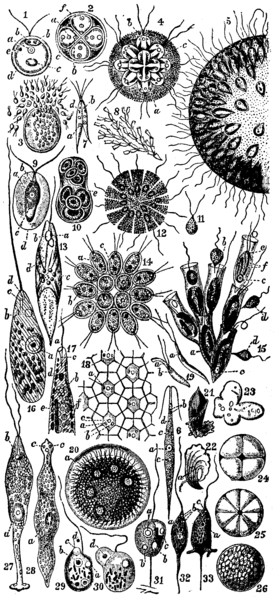| DescriciónFlagellata 1.png |
English: * 1. — Chlamydomonas pulvisculus, Ehr. (Chlamydomonadidae) free-swimming individual.
- a = nucleus.
- b = contractile vacuole.
- c = starch corpuscle.
- d = cellulose investment.
- e = stigma (eye-spot).
- 2. Resting stage of the same, with fourfold division of the cell-contents. Letters as before.
- 3. Breaking up of the cell-contents into minute biflagellate swarm-spores, which escape, and whose history is not further known.
- 4. Syncrypta volvox, Ehr. (Chrysomonadidae). A colony enclosed by a common gelatinous test c.
- a = stigma.
- b = vacuole (non-contractile).
- 5. Uroglena volvox, Ehr. (Chrysomonadidae). Half of a large colony, the flagellates embedded in a common jelly.
- 6. Chlorogonium euchlorum, Ehr. (Chlamydomonadidae).
- a = nucleus.
- b = contractile vacuole.
- c = starch grain.
- d = eye-spot.
- 7. Chlorogonium euchlorum, Ehr. (Chlamydomonadidae). Copulation of two liberated microgonidia.
- a = nucleus.
- b = contractile vacuole.
- d = eye-spot (so-called).
- 8. Colony of Dinobryon sertularia, Ehr. (Chrysomonadidae).
- 9. Haematococcus palustris, Girod (= Chlamydococcus, Braun, Protococcus, Cohn), one of the Chrysomonadidae; ordinary individual with widely separated test.
- a = nucleus.
- b = contractile vacuole.
- c = amylon nucleus (pyrenoid).
- 10. Dividing resting stage of the same, with eight fission products in the common test e.
- 11. A microgonidium of the same.
- 12. Phalansterium consociatum, Cienk. (Choanoflagellata); × 325. Disk-like colony.
- 13. Euglena viridis, Ehr.; × 300 (Euglenidae).
- a = pigment spot (stigma).
- b = clear space.
- c = paramylum granules.
- d = chromatophor (endochrome plate).
- 14. Gonium pectorale, O. F. Müller (Volvocineae). Colony seen from the flat side; × 300.
- a = nucleus.
- b = contractile vacuole.
- c = amylon nucleus.
- 15. Dinobryon sertularia, Ehr. (Chrysomonadidae).
- a = nucleus.
- b = contractile vacuole.
- c = amylon nucleus.
- d = free colourless flagellates, probably not belonging to Dinobryon.
- e = stigma (eye-spot).
- f = chromatophors.
- 16. Peranema trichophorum, Ehr. (Peranemidae), creeping individual seen from the back; × 140.
- 17. Anterior end of Euglena acus, Ehr., in profile.
- a = mouth.
- b = vacuoles.
- c = pharynx.
- d = stigma (eye-spot).
- e = paramylum-body.
- f = chlorophyll corpuscles.
- 18. Part of the surface of a colony of Volvox globator, L. (Volvocidae), showing the intercellular connective fibrils.
- a = nucleus.
- b = contractile vacuole.
- c = starch granule.
- 19. Two microgametes (spermatozoa) of Volvox globator, L.
- a = nucleus.
- b = contractile vacuole.
- 20. Ripe asexually produced daughter-individual of Volvox minor, Stein, still enclosed in the cyst of the partheno-gonidium.
- a = young, partheno-gonidia.
- 21, 22. Trypanosoma sanguinis, Gruby (Haematoflagellates), from the blood of Rana esculenta.
- 23—26. Reproduction of Bodo caudatus, Duj. (Bodonidae), after Dallinger and Drysdale:—23, fusion of several individuals (plasmodium); 24, encysted fusion-product dividing into four; 25, later into eight; 26, cyst filled with swarm-spores.
- 27. Distigma proteus, Ehbg., O.F. Müller (Euglenidae); × 440. Individual with the two flagella, and strongly contracting hinder region of the body.
- 28. The same devoid of flagella.
- c, c = the two dark pigment spots (so-called eyes) near the mouth.
- 29. Oicomonas termo (Monas termo) Ehr. (one of the Oicomonadidae).
- c = food-ingesting vacuole.
- d = food-particle; × 440.
- 30. The food-particle d has now been ingested by the vacuole.
- 31. Oicomonas mutabilis, Kent (Oicomonadidae), with adherent stalk.
- a = nucleus.
- b = contractile vacuole.
- c = food-particle in food vacuole.
- 32, 33. Cercomonas crassicauda, Duj. (Oicomonadidae), showing two conditions of the pseudo-podium-protruding tail.
- a = nucleus.
- b = contractile vacuoles.
- c = mouth.
|



